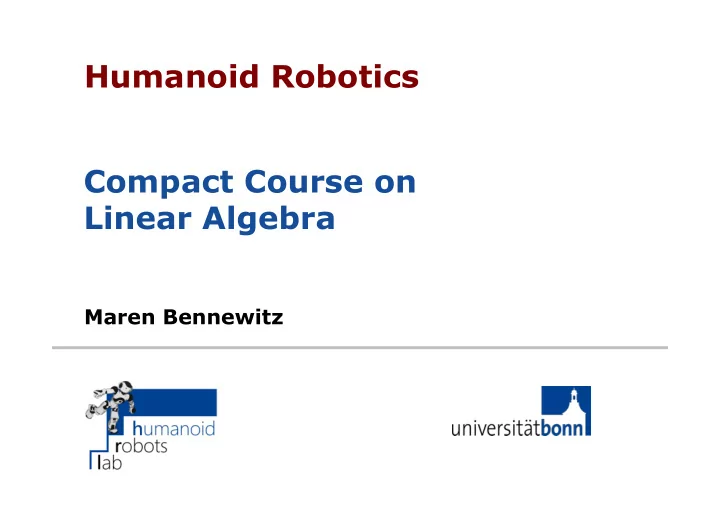

Humanoid Robotics Compact Course on Linear Algebra Maren Bennewitz
Vectors § Arrays of numbers § Vectors represent a point in a n dimensional space
Vectors: Scalar Product § Scalar-vector product § Changes the length of the vector, but not its direction
Vectors: Sum § Sum of vectors (is commutative) § Can be visualized as “chaining” the vectors
Vectors: Dot Product § Inner product of vectors (yields a scalar) § If , the two vectors are orthogonal
Vectors: Linear (In)Dependence § A vector is linearly dependent from if
Vectors: Linear (In)Dependence § A vector is linearly dependent from if
Vectors: Linear (In)Dependence § A vector is linearly dependent from if § If there exist no such that then is independent from
Matrices § A matrix is written as a table of values rows columns § 1 st index refers to the row § 2 nd index refers to the column
Matrices as Collections of Vectors § Column vectors
Matrices as Collections of Vectors § Row vectors
Important Matrix Operations § Multiplication by a scalar § Sum (commutative, associative) § Multiplication by a vector § Product (not commutative) § Inversion (square, full rank) § Transposition
Scalar Multiplication & Sum § In the scalar multiplication , every element of the vector or matrix is multiplied with the scalar § The sum of two matrices is a matrix consisting of the pair-wise sums of the individual entries
Matrix Vector Product § The i th component of is the dot product . § The vector is linearly dependent from with coefficients row vectors column vectors
Matrix Matrix Product § Can be defined through § the dot product of row and column vectors § the linear combination of the columns of scaled by the coefficients of the columns of
Matrix Matrix Product § If we consider the second interpretation, we see that the columns of are the “global transformations” of the columns of through § All the interpretations made for the matrix vector product hold
Inverse § If is a square matrix of full rank, then there is a unique matrix such that holds § The i th row of and the j th column of are § orthogonal (if i ≠ j ) § or their dot product is 1 (if i = j )
Matrix Inversion § The i th column of can be found by solving the following linear system: This is the i th column of the identity matrix
Linear Systems (1) § A set of linear equations § Solvable by Gaussian elimination (as taught in school) § Many efficient solvers exit, e.g., conjugate gradients, sparse Cholesky decomposition
Orthonormal Matrix § A matrix is orthonormal iff its column (row) vectors represent an orthonormal basis § The transpose is the inverse
Rotation Matrix (Orthonormal) § 2D Rotations: § 3D Rotations along the main axes § The inverse is the transpose (efficient) § IMPORTANT: Rotations are not commutative!
Recommend
More recommend